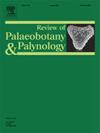青藏高原棕榈化石证明科希斯坦-拉达克岛弧是冈瓦纳和劳拉亚之间的植物区系垫脚石
IF 1.7
3区 地球科学
Q2 PALEONTOLOGY
引用次数: 0
摘要
棕榈树主要分布在泛热带地区,尽管全球化石记录丰富,但由于化石记录的空间分布不均匀,其进化和生物地理历史仍未得到解决。本文报道了青藏高原南部拉子县晚古新世棕榈叶化石。这些叶化石的特征是具无武装叶柄的重瓣扇形肋板,表明其属于蕨亚科。通过与其他棕榈叶化石记录的形态比较,我们将这些棕榈叶化石归为Sabalites化石属,特别是Sabalites striatipetiolaphyllum Y. Gao et T. Su sp. 11 .结合以往的棕榈化石记录,我们提出Kohistan-Ladakh岛弧是棕榈在古新世晚期从印度扩散到藏南的踏脚石,棕榈在始新世晚期传播到西藏中部地区。总的来说,本研究的棕榈化石为古近纪印度与亚洲植物区系的交换以及当时藏南的温暖气候提供了重要证据。本文章由计算机程序翻译,如有差异,请以英文原文为准。
Tibetan Plateau palm fossils prove the Kohistan-Ladakh Island Arc is a floristic steppingstone between Gondwana and Laurasia
Palms are mainly distributed in the pantropical regions and although the fossil records are rich globally, their evolutionary and biogeographic histories remain unresolved largely due to the uneven spatial distribution of fossil records. Here, we report late Paleocene palm leaf fossils from Lazi County, southern Tibetan Plateau. These fossil leaves, characterized by induplicate fan-shaped costapalmate laminae with unarmed petioles, suggest an affiliation with the subfamily Coryphoideae. With morphological comparisons to other palm leaf fossil records, we place these palm leaf fossils within the fossil genus Sabalites, specifically Sabalites striatipetiolaphyllum Y. Gao et T. Su sp. nov. Together with previous palm fossil records, we propose that the Kohistan-Ladakh Island Arc served as a steppingstone for the dispersal of palms from India to southern Tibet by the late Paleocene, and palms spread into central Tibetan region by the late Eocene. Overall, palm fossils in this study provide crucial evidence for floristic interchange between India and Asia during the Paleogene, as well as a warm climate in southern Tibet at that time.
求助全文
通过发布文献求助,成功后即可免费获取论文全文。
去求助
来源期刊
CiteScore
3.50
自引率
21.10%
发文量
149
审稿时长
6 months
期刊介绍:
The Review of Palaeobotany and Palynology is an international journal for articles in all fields of palaeobotany and palynology dealing with all groups, ranging from marine palynomorphs to higher land plants. Original contributions and comprehensive review papers should appeal to an international audience. Typical topics include but are not restricted to systematics, evolution, palaeobiology, palaeoecology, biostratigraphy, biochronology, palaeoclimatology, paleogeography, taphonomy, palaeoenvironmental reconstructions, vegetation history, and practical applications of palaeobotany and palynology, e.g. in coal and petroleum geology and archaeology. The journal especially encourages the publication of articles in which palaeobotany and palynology are applied for solving fundamental geological and biological problems as well as innovative and interdisciplinary approaches.

 求助内容:
求助内容: 应助结果提醒方式:
应助结果提醒方式:


